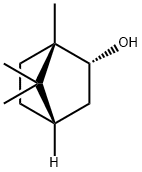(-)-Borneol , Analysis of standard products for pyrene analysis , 464-45-9
Synonym(s):
(−)-Borneol;endo-(1S)-1,7,7-Trimethylbicyclo[2.2.1]heptan-2-ol
CAS NO.:464-45-9
Empirical Formula: C10H18O
Molecular Weight: 154.25
MDL number: MFCD00003759
EINECS: 207-353-1
| Pack Size | Price | Stock | Quantity |
| 1G | RMB319.20 | In Stock |
|
| others | Enquire |
PRODUCT Properties
| Melting point: | 206-209 °C |
| Boiling point: | 210 °C(lit.) |
| alpha | -36.2 º (c=5, C2H5OH) |
| Density | 0.8389 (rough estimate) |
| vapor density | 5.31 (vs air) |
| vapor pressure | 33.5 mm Hg ( 25 °C) |
| FEMA | 2157 | BORNEOL |
| refractive index | -36 ° (C=5, EtOH) |
| Flash point: | 150 °F |
| storage temp. | Store below +30°C. |
| solubility | almost transparency in EtOH |
| pka | 15.36±0.60(Predicted) |
| form | Crystalline Powder or Crystals |
| color | White to light yellow |
| Odor | at 10.00 % in dipropylene glycol. pine woody camphor |
| Odor Type | balsamic |
| optical activity | [α]20/D 35.3°, c = 5 in ethanol |
| Water Solubility | INSOLUBLE |
| Merck | 14,1338 |
| BRN | 3587558 |
| LogP | 2.75 at 20℃ |
| CAS DataBase Reference | 464-45-9(CAS DataBase Reference) |
| NIST Chemistry Reference | Bicyclo[2.2.1]heptan-2-ol, 1,7,7-trimethyl-, (1S-endo)-(464-45-9) |
| EPA Substance Registry System | (-)-Borneol (464-45-9) |
Description and Uses
Borneol is an analgetic, antibacterial, and resuscitation-inducing norborneol derived from fresh branches and leaves of Cinnamomum camphora (L.) Presl. Far more than 2000?years ago, it has been introduced to China . In China, it has been firstly recorded in Ming Yi Bie Lu and then included in Tang Ben Cao. It was recorded in history that borneol was derived from Dryobalanops camphora gaertner and then precipitated from the resin to form the natural crystal compound or distilled from the trunk and cooled down to form the crystal compound, which is certified from Indonesia. In China, the natural borneol mainly relied on imports. In recent years, it was extracted from the Lauraceae plants, including Cinnamomum camphora, Cinnamomum longepaniculatum, and Cinnamomum burmannii, which greatlyincreases the resources of natural borneol for China. Cinnamomum camphora is mainly distributed in Jiangxi and Fujian provinces with 81.78% of borneol. Cinnamomum longepaniculatum is mainly distributed in Hunan and Sichuan provinces with 77.57% of borneol. Cinnamomum burmannii is mainly distributed in Yunnan and Guangxi provinces with 70.81% of borneol. Among them, Cinnamomum camphora contains more borneol than the other two types .
(-)-Borneol has been used to study its antiapoptotic, antioxidative and neuroprotective effect in human neuroblastoma cells (SH-SY5Y).
Safety
| Symbol(GHS) |  GHS02 |
| Signal word | Warning |
| Hazard statements | H228 |
| Precautionary statements | P210 |
| Hazard Codes | F,Xi |
| Risk Statements | 11-43 |
| Safety Statements | 16-36/37 |
| RIDADR | UN 1312 4.1/PG 3 |
| WGK Germany | 2 |
| RTECS | DT5095000 |
| TSCA | Yes |
| HazardClass | 4.1 |
| PackingGroup | III |
| HS Code | 29061900 |
| Toxicity | LD50 orally in Rabbit: 5800 mg/kg |




![Bicyclo[2.2.1]hept-2-ene](https://img.chemicalbook.com/CAS/GIF/498-66-8.gif)